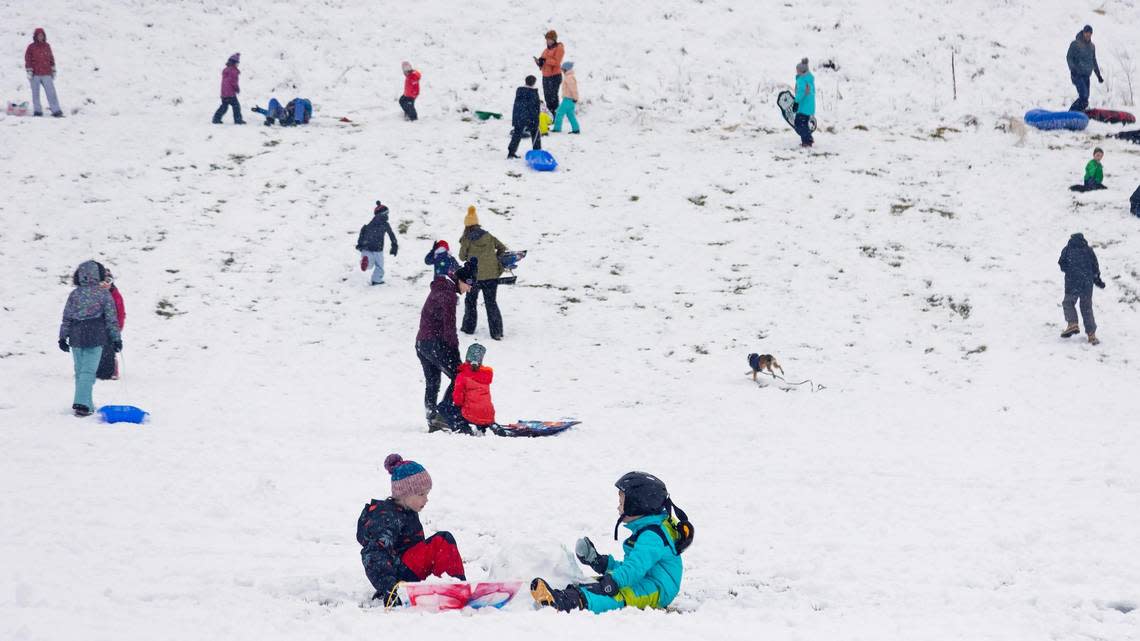Boise had one of snowiest winters in recent history. Here are the numbers behind it
It may not have felt like the snowiest winter in Boise this past season, but a consistently wet weather pattern has helped push the 2022-23 season into the top-five snowiest since the turn of the century.
March 1 marked the official end of winter on the meteorological calendar, which categorizes winter as December through February. Those operating off the regular astronomical calendar must wait until March 20 for spring to start.
With meteorological winter officially behind us, let’s look at how this winter stacks up to winters past.
Total Boise snowfall
Boise has picked up 23.8 inches of snow this winter, including 3.7 inches that have fallen so far in March. With some snowstorms still to move through the region before temperatures pick up for good, this winter ranked 5th-snowiest since 2000 and the snowiest since Snowmageddon in January 2017.
The average since snowfall records began in 1950 is 20.1 inches.
With no real opportunity for significant snowfall in March here’s how the 2022-23 winter season compares with the top five since 2000.
2016-17: 39.1 inches
2008-09: 33.7 inches
2001-02: 32.1 inches
2007-08: 31.8 inches
2022-23: 23.8 inches
The snowiest winter ever in Boise was 41.7 inches in 1951-52.
Despite this year’s above-average snowfall, Boise’s total precipitation between December and February was 3.19 inches. The average precipitation for the city is 3.81 inches, National Weather Service meteorologist Dave Groenert told the Idaho Statesman.
An inch of rain is equivalent to 13 inches of snow, according to the National Oceanic and Atmospheric Administration. Boise has had above-average snowfall despite having below-average precipitation because whenever there was a storm, it was typically cold enough to fall as snow, Groenert said.
He also said that he’s often heard from people that they mistakenly think the past winter wasn’t very snowy.
“The thing about this winter is it was above normal (snow), but it’s a lot of these little one inch here and one inch there, and that adds up,” Groenert said.

Boise temperature compared to snowfall
Breaking down Boise’s monthly numbers for snowfall and temperature support Groenert’s assessment that whenever precipitation falls as snow, it was typically colder than usual.
December 2022:
Temperature: 29.2 degrees (BELOW average of 32.1 degrees)
Snowfall: 9.4 inches (ABOVE average of 5.6 inches)
January 2023:
Temperature: 33.5 degrees (ABOVE average of 32.2 degrees)
Snowfall: 3.8 inches (BELOW average of 5.3 inches)
February 2023:
Temperature: 35.1 degrees (BELOW average of 37.5 degrees)
Snowfall: 3.4 inches (ABOVE average of 3.3 inches)
Boise’s heaviest snowstorm came in mid-December when the city picked up 4.3 inches thanks to snow bands lining up perfectly over the Treasure Valley.
How hot — or cold — did it get?
Boise generally experienced lower temperatures than usual outside of a warm spell in January this winter.
Here are the number of days during the winter above or below certain thresholds:
High temperature 50 degrees or above: 12
High temperature 40-49 degrees: 41
High temperature 30-39 degrees: 25
High temperature 30 degrees or below: 12

Low temperature 30 degrees or above: 22
Low temperature between 20-29 degrees: 51
Low temperature between 10-19 degrees: 14
Low temperature 10 degrees or below: 3
The lowest temperature of the winter came on Dec. 19 when it dropped to 6 degrees, but the highest temperature came just over a week later when it soared to 56 degrees on Dec. 27.
Is La Niña to blame?
Groenert said that this past winter resembled more of a typical La Niña year, which occurs when the temperature of the sea is cooler than average in the eastern Pacific Ocean. According to NOAA, a typical weather pattern during a La Niña is cool and wetter than average temperatures in the Pacific Northwest and warmer and drier than average weather in the southern United States.
This past winter was the third La Niña in a row, which is incredibly rare. The only other two times it’s happened on record are from 1973 to 1976 and 1998 to 2001, according to previous Statesman reporting.
“This feels like a more typical La Niña, especially as we’ve gotten into January, February and March, where it’s been below our normal temperatures,” Groenert said. “The general above-normal snowfall usually tracks with that. But it’s hard to say because last year was a La Niña, and we didn’t really have that.”
